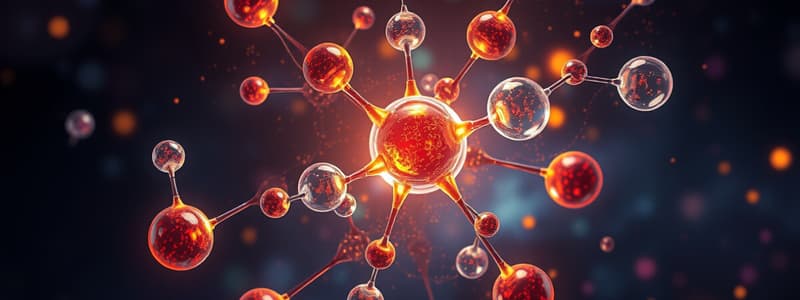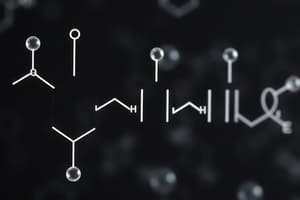Podcast
Questions and Answers
What is the term for a compound characterized by an -OH group?
What is the term for a compound characterized by an -OH group?
- Aldehyde
- Alcohol (correct)
- Alkane
- Alkene
Which of the following describes a compound with the functional group -CHO?
Which of the following describes a compound with the functional group -CHO?
- Ketone
- Alkane
- Aldehyde (correct)
- Amine
What do we call a hydrocarbon with only single bonds?
What do we call a hydrocarbon with only single bonds?
- Aromatic Compound
- Alkane (correct)
- Alkyne
- Alkene
Identify the compound that contains a carbon-carbon double bond.
Identify the compound that contains a carbon-carbon double bond.
What is the name of a compound that contains a halogen atom?
What is the name of a compound that contains a halogen atom?
Which functional group is indicated by a triple bond between carbons?
Which functional group is indicated by a triple bond between carbons?
Identify the functional group characterized by the structure RCONH2.
Identify the functional group characterized by the structure RCONH2.
Which functional group contains a nitrogen atom bonded to two carbon atoms?
Which functional group contains a nitrogen atom bonded to two carbon atoms?
What do we call a compound that has a cyclic structure with alternating double bonds?
What do we call a compound that has a cyclic structure with alternating double bonds?
Identify the compound characterized by the functional group -COOH.
Identify the compound characterized by the functional group -COOH.
Which functional group contains a carbon atom bonded to an oxygen atom by a double bond and also to an alkyl group?
Which functional group contains a carbon atom bonded to an oxygen atom by a double bond and also to an alkyl group?
What is the name of the compound that contains an oxygen atom bonded to two carbon atoms?
What is the name of the compound that contains an oxygen atom bonded to two carbon atoms?
Identify the functional group characterized by a carbon atom double-bonded to an oxygen atom.
Identify the functional group characterized by a carbon atom double-bonded to an oxygen atom.
Flashcards
Alcohol
Alcohol
Contains -OH group on a saturated carbon.
Aldehyde
Aldehyde
Carbonyl group (C=O) bonded to hydrogen.
Alkene
Alkene
Carbon-carbon double bond (C=C).
Alkane
Alkane
Signup and view all the flashcards
Halide
Halide
Signup and view all the flashcards
Amine
Amine
Signup and view all the flashcards
Amide
Amide
Signup and view all the flashcards
Alkyne
Alkyne
Signup and view all the flashcards
Aromatic Compound
Aromatic Compound
Signup and view all the flashcards
Carboxylic Acid
Carboxylic Acid
Signup and view all the flashcards
Ester
Ester
Signup and view all the flashcards
Ether
Ether
Signup and view all the flashcards
Ketone
Ketone
Signup and view all the flashcards
Study Notes
Organic Chemistry Functional Groups
-
Alcohol: Contains one or more hydroxyl (-OH) groups attached to a saturated carbon atom. Commonly used in beverages and solvents.
-
Aldehyde: Characterized by a carbonyl group (C=O) bonded to at least one hydrogen atom. Found in various compounds, including formaldehyde, and is important in organic synthesis.
-
Alkane: A hydrocarbon with only single bonds, following the general formula CnH2n+2. Examples include methane and propane, known for being saturated and non-reactive compared to other hydrocarbons.
-
Alkene: Features at least one carbon-carbon double bond (C=C), following the formula CnH2n. Commonly used in the production of plastics and synthetic rubbers.
-
Halide: Contains a carbon atom bonded to one or more halogen atoms (F, Cl, Br, I). These compounds are widely used in pharmaceuticals and as solvents.
-
Alkyne: Contains at least one carbon-carbon triple bond (C≡C), following the formula CnH2n-2. Commonly found in industrial applications, like welding gases.
-
Amide: Formed from the reaction of carboxylic acids with amines, featuring a carbonyl group bonded to a nitrogen atom. Important in peptide bond formation in proteins.
-
Amine: Derivatives of ammonia with one or more hydrogen atoms replaced by alkyl or aryl groups. These compounds can act as bases and are important in biological molecules.
-
Aromatic Compound: Contains one or more aromatic rings characterized by cyclic structure and resonance. Notable examples include benzene, known for stability and unique reactivity.
-
Carboxylic Acid: Contains a carboxyl group (-COOH) which includes a carbonyl (C=O) and hydroxyl (OH). Commonly found in organic acids like acetic acid and crucial in biological systems.
-
Ester: Formed from the reaction of an alcohol and a carboxylic acid. Characterized by the -COO- group and commonly present in fats and oils, contributing to their flavors and fragrances.
-
Ether: Contains an oxygen atom connected to two alkyl or aryl groups. Known for being relatively unreactive and commonly used as solvents in organic reactions.
-
Ketone: Contains a carbonyl group (C=O) bonded to two carbon atoms, located within a carbon chain. Examples include acetone, used widely as a solvent and nail polish remover.
Studying That Suits You
Use AI to generate personalized quizzes and flashcards to suit your learning preferences.




